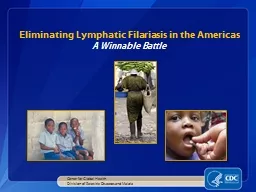

Filariasis in the Americas A Winnable Battle Center for Global Health Division of Parasitic Diseases and Malaria Lymphatic Filariasis LF Caused by worms spread from persontoperson by the bite of infected mosquitoes ID: 266019
Download Presentation The PPT/PDF document "Eliminating Lymphatic" is the property of its rightful owner. Permission is granted to download and print the materials on this web site for personal, non-commercial use only, and to display it on your personal computer provided you do not modify the materials and that you retain all copyright notices contained in the materials. By downloading content from our website, you accept the terms of this agreement.
Slide1
Eliminating Lymphatic Filariasis in the AmericasA Winnable Battle
Center for Global Health
Division of Parasitic Diseases and MalariaSlide2
Lymphatic Filariasis (LF)Caused by worms spread from person-to-person by the bite of infected mosquitoes
The worms live in the human lymphatic system and can cause:
Lymphedema (swelling) and elephantiasis in limbs and breasts
Hydrocele (severe fluid accumulation) affecting men’s genitalia
Microfilaria of
Wuchereria
bancrofti
(CDC photo,
DPDx
)
Microfilaria of
Brugia
malayi
(CDC photo,
DPDx
)Slide3
Health and societal impacts of LFCDC photos
L
ymphedema
E
lephantiasis
Usually develop years after initial infection
Cause pain, severe and irreversible disfigurement, loss of productivity, and social stigmatizationSlide4
LF: A costly and disabling NTDOne of the most disabling and economically costly neglected tropical diseases (NTDs
)NTDs are a group of poverty-associated parasitic and bacterial infections affecting more than 1 billion persons
NTDs are responsible for tremendous suffering and economic lossMore than 120 million persons are infected with LF, a disease that can be eliminated
Photo courtesy Carter Center/Emily
StaubSlide5
Worldwide distribution of LF
1.34 billion at
risk in
worldSlide6
Global impact of LFA leading cause of disability globally
Present in 73 countries44 million persons suffer from chronic manifestations
Photos courtesy of CDC. Left: Dr. Susan Montgomery, Middle and Right: CDC PHILSlide7
Global Programme to Eliminate LF (GPELF)Target elimination date of 2020
Launched by World Health Organization (WHO) in 2000 Two-pronged strategy to:
Interrupt the spread of infection Reduce the suffering of persons already infectedTo interrupt infection, medication is
distributed to entire at-risk population through mass drug administration (MDA)At least 5 rounds on MDA are needed to interrupt transmissionTreatment kills worms circulating in the bloodSlide8
GPELF: Progress and successes53 countries have ongoing MDA campaigns37 countries have administered 5 or more rounds of MDA in many target areas2.8 billion doses of medicine delivered in first 9 years
Treatment cost typically less than US $0.50 per person and often less than $0.10Transmission interruption has protected 6.6 million newborns from becoming infected with the disease
Economic benefit of first 7 years of program estimated at $24 billion Full economic benefit could exceed US $55 billionSlide9
The economic impact of GPELF, 2000-2007
Table courtesy of WHO GPELF Slide10
Passive Surveillance ( > 5 years)
“Mapping”
TAS
TAS
TAS
n
Monitoring & Evaluation
1
Rounds annual
mass drug administration (MDA)
2
3
4
5
Coverage
Impact Assessment
WHO Guidelines for LF Elimination Programs
Post-MDA Period
TAS = transmission assessment surveySlide11
LF elimination in the AmericasThe Americas is the first region targeted for elimination of LFImprovements in standard of living have reduced disease prevalence in continental Americas and Caribbean Islands
In areas where disease remained (Costa Rica, Suriname, and Trinidad and Tobago), transmission was interrupted through selective and community treatment
Transmission still occurs in Guyana, Haiti, and parts of Brazil and the Dominican RepublicSlide12
Notable achievements in the AmericasSurveys carried out in the Dominican Republic suggest transmission interruptionMDA treatment scaling up in
Haiti3 rounds of MDA have been completed in Haiti, including the urban capital of Port-au-Prince
Many departments of Haiti are ready to begin transmission assessment surveys (TAS) to determine if MDA can be stopped
Disease management programs operating in all four endemic countries
CDC photoSlide13
Notable achievements in the AmericasAlthough there is still active transmission in Guyana, Haiti, and parts of Brazil and the Dominican Republic, each country has achieved notable success in the fight against LF
As of late 2012,
nearly 9 million persons living in Americas had received MDAElimination in the Americas is within reachSlide14
Graph courtesy of WHO GPELF Slide15
CDC and partner supportCDC and its partners:Work with each country’s ministry of health to offer advice and expert consultationDevelop monitoring and evaluation strategies
Provide technical supportCarry out operational research including working to understand:
Adherence to medicationOptimal surveillance methodsStrategies to accelerate eliminationSlide16
Winning the battle against LF:What more can be done to eliminate LF by 2020?Continue and scale-up MDA programs to interrupt transmissionUse operational
research to develop strategies to accelerate the elimination of LFIncrease each country’s efforts
to provide appropriate care for persons with filarial diseaseExpand the reach of LF programs to
include service delivery for other NTDs and health prioritiesSlide17
CDC partnersWe would like to acknowledge and thank our partners working to eliminate lymphatic
filariasis:The Bill & Melinda Gates FoundationCBM International
EisaiGlaxoSmithKlineIMA World Health
Inter-American Development BankMerckPan American Health OrganizationRTI InternationalThe Task Force for Global HealthUniversity of Notre Dame
United States Agency for International Development (USAID)Slide18
Thank you www.cdc.gov/winnablebattles
/lymphaticfilariasis
Center for Global Health
Division of Parasitic Diseases and Malaria